2021年七年级英语上册Unit5Doyouhaveasoccerball知识点总结新版人教新目标版
七年级英语上册 Unit 5 Do you have a soccer ball(单词+重点句型)语法解析
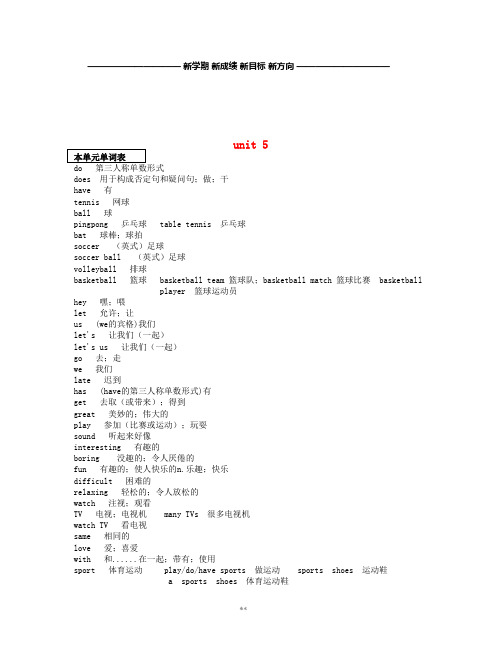
——————————新学期新成绩新目标新方向——————————unit 5does 用于构成否定句和疑问句;做;干have 有tennis 网球ball 球pingpong 乒乓球 table tennis 乒乓球bat 球棒;球拍soccer (英式)足球soccer ball (英式)足球volleyball 排球basketball 篮球 basketball team 篮球队;basketball match 篮球比赛 basketball player 篮球运动员hey 嘿;喂let 允许;让us (we的宾格)我们let's 让我们(一起)let's us 让我们(一起)go 去;走we 我们late 迟到has (have的第三人称单数形式)有get 去取(或带来);得到great 美妙的;伟大的play 参加(比赛或运动);玩耍sound 听起来好像interesting 有趣的boring 没趣的;令人厌倦的fun 有趣的;使人快乐的n.乐趣;快乐difficult 困难的relaxing 轻松的;令人放松的watch 注视;观看TV 电视;电视机 many TVs 很多电视机watch TV 看电视same 相同的love 爱;喜爱with 和......在一起;带有;使用sport 体育运动 play/do/have sports 做运动 sports shoes 运动鞋a sports shoes 体育运动鞋them (they的宾格)他(她、它)们only 只;仅like 喜欢;喜爱easy 容易的;不费力的after 在......以后class 班级;课(近义词:lessen);等级;类别;阶段classmate 同班同学 roommate 室友 workmate 同事 deskmate 同桌schoolmate 校友Bill 比尔(男名)on的用法,详见unit4【解析】on可以表示“通过;使用……方式”,后面通常接表示通信工具的名词。
新目标英语七年级上册_unit_5_Do_you_have_a_soccer_ball B

let sb. do sth让某人做某事
Grammar Focus:
Do you have a baseball?
Yes, I do./ No, I don't. I have a volleyball.
Do you have a ping-pong bat?
where's=where is ,对地点提问,后接单数名词。
Let's 是 let us的缩写。 let’s包括说话人在内,let us不包括说话人在内。 本句是以let开头的祈使句,结构为“Let’s do sth.”, 意为“咱们……吧”,常用于提出建议。如: Let’s play basketball.
Yes, I do./ No, I don't. I have a ping-pong ball. Yes, they do./ No, they don't. They have a volleyball.
Do they have a basketball?
Does she have a tennis ball? Does he have a soccer ball?
× ×
×
1b Listen and circle the words you hear.
ping-pong bat
volleyball
soccer ball
ping-pong ball
Listening
A: Do you have a ping-pong bat?
B: Yes, I do.
A: Do you have a ping-pong ball?
Unit 5 Do you have a soccer ball 知识点归纳-七年级上册英语

人教版新目标七上英语单元知识点归纳Unit 5 Do you have a soccer ball?重点词汇tennis/'tenis/ n. 网球bat /bæt/ n. 球棒;球拍soccer ball (英式)足球volleyball/'vɔlibɔ:l/ n. 排球basketball/'ba:skitbɔ:l/ n. 篮球late/leit/ adj. 迟到great/greit/ adj. 美妙的;伟大的play/plei/ v. 参加(比赛或运动);玩耍sound/saund/ v. 听起来好像interesting/'intrəstiŋ/ adj. 有趣的boring/'bɔ:riŋ/ adj. 没趣的;令人厌倦的fun/fʌn/ adj. 有趣的;使人快乐的n.乐趣;快乐difficult/'difikəlt/ adj. 困难的relaxing/ri'læksiŋ/ adj. 轻松的;令人放松的watch/wɔtʃ/ v. 注视;观看same/seim/ adj. 相同的easy/'i:zi/ adj. 容易的;不费力的class/kla:s/ n. 班级;课classmate/'kla:smeit/ n. 同班同学重点短语:a tennis bat 一个网球拍play basketball 打篮球baseball bat 棒球棒have a soccer ball 有一个足球play soccer 踢足球with our friends 和我们的朋友一起have a ping-pong ball 有一个乒乓球play ping-pong 打乒乓球have a volleyball 有一个排球play volleyball 打排球at school 在校,上学play sports 做运动watch TV 看电视in my bag 在我的包里be late 迟到on TV 电视上必背典句:1. Do you have a soccer ball? 你有一个足球吗?2. Does he/she have a ping-pong ball?他/她有一个乒乓球吗?3. Do you play sports with your classmates? 你和你的同学一起做运动吗?4. Let’s play soccer together! 我们一起踢足球吧!5. How many sports do you like?你喜欢多少种运动?6. I like playing soccer and basketball. 我喜欢踢足球和打篮球。
七年级英语上册 Unit 5 Do you have a soccer ball(第5课时)

Unit 5 Do you have a soccer ball? 学习内容学习目标知识与技能:1.复习掌握本单元单词和短语2.熟练掌握提建议的句型Let's--3.会正确运用Do you have…?Does he/she have…?来谈论物主关系4.学会写某人所拥有物品的短文过程与方法:通过听,说等一些活动培养良好的听力习惯和能力,再通过通过独学和小组合作,学会使用本单元重点句型。
情感态度与价值观:每个人要有自己的爱好。
重点难点1.会正确运用Do you have…?Does he/she have…?来谈论物主关系2.学会写某人所拥有物品的短文学具准备录音机、磁带、课本,导学案学习形式教师导学,学生小组合作学习学习过程学生学案一、回顾反馈预习提纲:有_________ 乒乓球________________ 排球___________ 篮球____________玩,打____________ 听起来____________ 运动____________ 我们___________大量的_________ 更多的____________ 班级____________有趣的_________令人生厌的___________ 令人愉快的________ 困难的___________轻松的__________ 美妙的____________ 收藏品____________ 但是教师导案谈话导入新课:回顾复习旧知识生学习目标老师检测预习组长汇报老师巡视检查自主完成全员参与补充内容板书课题:。
英式足球_____________ 网球拍____________ 看电视___________做运动___________ 每天____________二、明确目标学案导学学生自渎目标明确学习目标三、自主学习合作探究1.自读Part3,排序2.小组讨论答案,并讨论汉语意思.3.小组为单位展示答案.4.两人一组练习对话,小组展示.5.背诵对话.四、展示提炼拓展延伸小组讨论如何翻译以下句子.1.你有乒乓球吗?不,我没有.2.他有一个足球吗?是的,他有.3.他们有一台电脑吗?是的,他们有.五、达标测试效果反馈:(一)根据句意及首字母提示补全单词1.Do you have a tennis r__________?2.In our school,we have m_______ clubs.3.We w_________ TV every day.4.These questions are very d_____________.5.Please j________ us soon.6.We have many c________:volleyball,basketball,ping-pong(二)翻译短语1.打排球____________________2.玩电子游戏__________________________3.看电视___________________4.踢足球______________5.做运动6.听起来很有趣7.体育俱乐部_____ ___ 8.那么难______________________ 9.每天___________________ 10.大量的体育收藏品___________________11.8个网球拍_________________ 12.在电视上收看它们__________________(三)选择1._________you have a pen? A.do B.does C.Do D.Does2.—Do Lucy and Lily have a baseball? —Yes,____________.A.she doesB.she hasC.they doD.they have3.—Let's play basketball. —No,_____________.A.it's boringB.it's interestingC.it's goodD.it's fun4. Let's __________TV. A.look B.look at C.seeD.watch5. Do you play _______?A.basketballsB.a basketballC.basketballD.the basketball6. Let's _____________.A.play ping-pongB.to play ping-pongC.playing ping-pongD.play the ping-pong7. Let_______ play sports. A.we C.is D.has(四)用所给动词的正确形式填空.1. Let's ___________ (play) soccer.2. That ___________ (sound) boring.3.—______she _______(have) a phone? -----No,sh e doesn't4. Sue _________(not have) a great sp orts collection.(五)句型转换1. I have a soccer ball.(改为一般疑问句)课后反思:。
Unit 5 Do you have a soccer ball 七年级上课文原文及重点
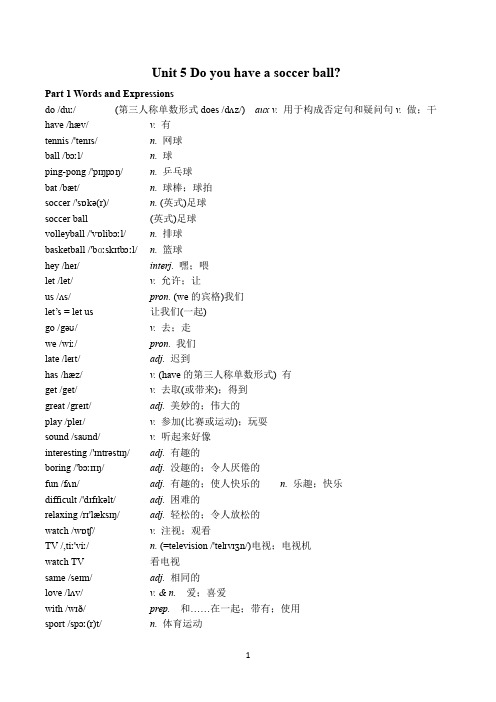
Unit 5 Do you have a soccer ball?Part 1 Words and Expressionsdo /duː/ (第三人称单数形式does /dʌz/) aux v.用于构成否定句和疑问句v.做;干have /hæv/ v.有tennis /'tenɪs/ n. 网球ball /bɔːl/ n.球ping-pong /'pɪŋpɔŋ/ n. 乒乓球bat /bæt/ n. 球棒;球拍soccer /'sɒkə(r)/ n. (英式)足球soccer ball (英式)足球volleyball /'vɒlibɔːl/ n.排球basketball /'bɑːskɪtbɔːl/ n.篮球hey /heɪ/ interj.嘿;喂let /let/ v. 允许;让us /ʌs/ pron. (we的宾格)我们let’s = let us 让我们(一起)go /gəʊ/ v.去;走we /wiː/ pron.我们late /leɪt/ adj. 迟到has /hæz/ v. (have的第三人称单数形式) 有get /get/ v.去取(或带来);得到great /greɪt/ adj.美妙的;伟大的play /pleɪ/ v. 参加(比赛或运动);玩耍sound /saʊnd/ v.听起来好像interesting /'ɪntrəstɪŋ/ adj.有趣的boring /'bɔːrɪŋ/adj.没趣的;令人厌倦的fun /fʌn/ adj.有趣的;使人快乐的n.乐趣;快乐difficult /'dɪfɪkəlt/ adj. 困难的relaxing /rɪ'læksɪŋ/ adj.轻松的;令人放松的watch /wɒtʃ/ v.注视;观看TV /,tiː'viː/ n. (=television /'telɪvɪʒn/)电视;电视机watch TV看电视same /seɪm/ adj. 相同的love /lʌv/ v. & n. 爱;喜爱with /wɪð/ prep.和……在一起;带有;使用sport /spɔː(r)t/ n. 体育运动them /ðəm/ pron. (they的宾格) 他(她、它)们only /'əʊnli/ adv.只;仅like /laɪk/ v. 喜欢;喜爱easy /'iːzi/ adj.容易的;不费力的after /'ɑːftə(r)/prep. & conj.在……之后class /klɑːs/ n.班级;课classmate /'klɑːsmeɪt/ n.同班同学Bill /bɪl/比尔(男名)Part 2:Texts课文(一)Cindy:Hey, Helen, let’s go! We’re late!Helen: OK.Cindy: Do you have the baseball?Helen: Yes, I do. It’s in my bag.Cindy: And where’s our baseball bat?Helen: Bill has it.Cindy: Oh, yeah. And do you have your jacket?Helen: Oh, no, I don’t. It’s on the chair. Let me get it. Cindy: And your hat, too!Helen: OK, I have my jacket and hat. Let’s go!Structure1. Do you have a baseball?Yes, I do./No, I don’t. I have a volleyball.2. Do you have a ping-pong bat?Yes, I do./No, I don’t. I have a ping-pong ball.3. Does she have a tennis ball?Yes, she does./No, she doesn’t. She has a baseball.4. Does he have a soccer ball?Yes, he does./No. he doesn’t. He has two ping-pong bats. 5. Do they have a basketball?句型:—Do/Does sb. have…?—Yes, sb. do / does.—No, sb. don’t / doesn’t.Write each word in the correct place in the chart.将方框中的单词填入表格中正确的位置。
七年级英语上册Unit5-Do-you-have-a-soccer-ball优秀教案
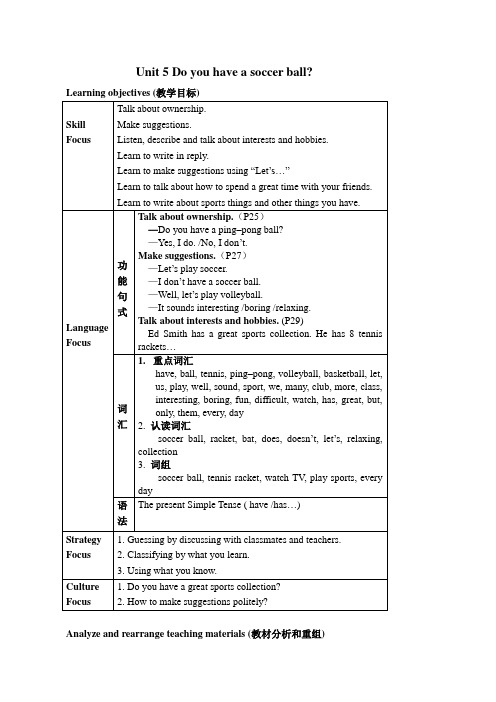
Unit 5 Do you have a soccer ball? Learning objectives (教学目标)Analyze and rearrange teaching materials (教材分析和重组)1. 教材分析本单元以“Do you have a soccer ball?”为话题, 共设计了三个部分的内容。
Section A该部分有4个模块:第一模块围绕“Do you have a soccer ball?”这一话题展开词汇学(1a)、听力(1b)、口语(1c)训练;第二模块继续围绕“Do /Does… have a…?”进行听力(2a-2b)、口语训练(2c);第三模块围绕“Make suggestions.”这一话题展开训练,训练形式为单词填空(3a)和角色表演谈论图画为训练形式(3b);第四模块就“Complete the forms according to the sports club you like.”以结对活动形式进行介绍。
Section B该部分有4个模块:第一模块是词汇的学习(1a)与运用(1b);第二模块仍然围绕(1a-1b) 的词汇进行听力训练(2a-2b)、围绕提建议进行口语训练(2c);第三模块继续围绕“Ownership”这一话题展开有关收藏品阅读(3a), 写作训练(3b-3c);第四模块仍就“Ownership”这一话题以口语训练形式展开全班活动。
Self Check该部分有3个模块:第一模块以填空形式对所学词汇进行训练;第二模块以默写已学过的五个单词的形式对所学的词汇继续巩固复习; 第三模块围绕有关ownership和suggestions对话开展口语训练和写作训练。
教材重组和课时分配Period 1 (Section A: 1a, 1b, 1c) New function presenting Period 2 (Section A: 2a, 2b, 2c, 3a, 3b, 4) PracticePeriod 3 (Section B: 1a, 1b, 2a, 2b, 2c) V ocabulary building Period 4 (Section B: 3a, 3b, 4) Integrating skillsPeriod 5 (Self Check: 1, 2, 3 & Workbook) Self CheckPeriod 6 WritingTeaching procedures and ways (教学过程与方式)Period One New function presentingLanguage goals (语言目标)1. Words & expressions: have, soccer ball, tennis, racket, tennis racket,ping–pong, volleyball, basketball, bat (P25)2.Key sentences: Do you have a ping–pong ball?Yes, I do. No, I don’t. (P25)Ability goals (能力目标)Enable the students to understand and talk about ownership and make suggestions.Emotion & attitude goals (情感和态度目标)Enable the students to form positive attitude toward sports collection and love sports, keep healthy and learn to make suggestions politely. Strategy goals (策略目标)To understand the target language by reading pictures, drawing pictures, countingnumbers, drawing a chart.Culture awareness goals (文化意识目标)People’s attitude toward sports collections is different in English speaking countries.Teaching important points (教学重点)Talk about ownership and make suggestions.Teaching procedures & ways (教学过程和方式)Step 1. Revision and Lead-inAsk one or more students to show their homework.T: In the last unit, I ask you to do a project about filling in the chart because we want to have a ball game. But we don’t know what kind of balls you have. Please ask your classmates in the group what balls he /she has. Then write down the information in the chart. Now who wants to display your project on the blackboard?T: Do you have tennis? S: Yes, I do.Second point to the others in the classroom.T: Does Wang Wei have tennis? S: Yes, he does.Third point to Li Hong in the classroom who has ping–pong ball, but no tennis.T: Do you have tennis?S: No, I don’t.T: Do you have a ping–pong ball?S: Yes, I do.T: Does Li Hong have tennis?Ss: No, she doesn’t.T: Does Li Hong have a ping–pong ball?Ss: Yes, she does.T: Today we are going to learn how to talk about ownership and make suggestions.Step 2. Listing and SpeakingAsk the students to read the picture on Page 25.T: What can you see in the picture?Ss: We can see a ping–pong ball, a ping–pong bat, a tennis racket, a soccer ball, volleyball, a basketball, a TV, a computer game.T: Ask the students to match the words with the things in the picture.Ss: Say, Number 1 is (C), tennis racket. Number 2 is (a), ping–pong ball…After checking the answers in 1a, ask the students to read aloud the new words again and again, ask and answer about them in pairs. And then play the recording again. This time students listen to conversation and circle the words they hear. And then check the answers. Students circle ping–pong bat and computer game.Step 3. Pair workAsk the students to read the example conversation. Have students repeat. And then point to the television in the illustration and substitute that word in the conversation. Have students repeat again. And then ask students to practice the conversation in pairs and remind them to use various objects from the illustration. As students practice, move around the classroom to check progress and help with pronunciation.Ask for more ideas from the students and write their ideas on the blackboard.p hone, cars, pencil case, eraser, pen, book, dictionary, watch, key, notebook, ring, sister , brother, chair, bookcase, CD, video tape, hat, desk, dresser…Show the following to the students and then ask them to practice in pairs.—Do you have a phone?—Yes, I do.—Do you have a CD?—No, I don’t.T: Now work in pairs, make conversations with the newwords in 1a and act it out around the students.Sample conversations:1. S1: Do you have a ping–pong bat?S2: Yes, I do.S1: Do you have a ping–pong bat?S2: No, I don’t.2. S3: Do you have volleyball?S4: Yes, I do.S3: Do you have a basketball?S4: No, I don’t.3. S5: Do you have a tennis racket?S6: Yes, I do.S5: Do you have a TV?S6: No, I don’t.Step 4. Homework1. Ask the students to do more practice as required in 1 c on Page 25.2. Ask the students to prepare the next period. Think about the usage of “Does she /he have…?”Period Two PracticeLanguage goals (语言目标)1. Words & expressions: does, doesn’t, let, us, let’s, play, well, sound,good, sport, we, many, club, more, class (P26)2. Key sentences:—Let’s play volleyball.—That sounds good. (P26)Ability goals (能力目标)Enable the students to make suggestions politely.Emotion & attitude goals (情感和态度目标)Train the Ss to make suggestions politely and take activity part in school sports club and keep healthy.Strategy goals (策略目标)Enable the students to match the problems and worries.Culture awareness goals (文化意识目标)Learn to how to make suggestions politely.Teaching important points (教学重点)Talk about making suggestions.Teaching procedures & ways (教学过程和方式)Step 1. RevisionBefore class, let’s have a revision. First make up a conversation with “Do you have…?”about ownership, and then in threes make up a conversation with “Do you have…? Does she /he have…?”Sample dialogues:1. S1: Do you have a soccer ball? S2: Yes, I do.S1: Do you have a basketball? S2: No, I don’t.2. S1: Do you have a computer game? S2: No, I don’t.S1: Do you have a ping–pong bat? S2: Yes, I do.S3: Does he have a computer game? S1: No, he doesn’t.S3: Does he have a ping–pong bat? S1: Yes, he does.Step 2. Listening PracticePlay the recording for the first time.T: Listen to the tape. You only listen.Play the recording for the second time. Then check the answers.T: You’ll hear the same conversation again in the picture. This time please listen for the names in the pictures, and then number the pictures (1-4).After that ask a few students to say out their answers in 2a.S1: The answers are 3, 1, 4, 2.S2: Number the pictures: 3, 1, 4, 2.Play the recording for the third time.T: You will hear the conversations for the third time. You are to match the people from activity 2a to the balls in the recording for the fourth time and then correct the answers.T: You listen to the tape and write the numbers from the pictures in 2b next to the correct balls.After doing listening, talk about the dialogue about 2b, and then ask some students to say out their answers in 2b.S3: The answers are 3, 2, 1, 4.S4: They are 3, 2, 1, 4.Step 3. Pair workLook at the things in the picture. Ask your partner if he /she has the things in 2c.Ask the students to act out the conversation in pairs.Sample conversations:1. S1: Do you have a dictionary? S2: Yes, I do.S1: Do you have an eraser? S2: No, I don’t.2. S3: Do you have a baseball? S4: No, I don’t.S3: Do you have a football? S4: Yes, I do.3. S5: Does Tom have volleyball? S6: Yes, he does.S6: Does Mike have a pen? S5: No, he doesn’t.Step 4. PracticeLook at 3a, point out the words in the box and then ask a student to read aloud the four words to the class.T: Fill in the blanks with the words from the box alone. I’m sure you’ll fill in the correct answers. And now who’ll tell me the answers? Please hand up if you know the answers. Oh, thank you, --------!S1: The answers are: 1. don’t,2. Let’s,3; have,4. soccer.T: You are right. Thank you. Now let’s practise reading aloud the conversations in pairs and act them out. And then tell the students how to make suggestions politely using “Let’s…!”For example:T: Let’s play ping–pong ball./ Let’s play tennis./ Let’s play volleyball…S: That sounds good.After finishing practising the conversations in 3a, ask the students to make conversations with their partners according to the pictures below in 3b. Ask the students to point to each one and describe each object. Show the students how to use the pairs of pictures as substitutes in the conversation.For example:T: Let’s play basketball.S: I don’t have a basketball.T: Well, let’s play football.S: That sounds good.Ask pairs of students to perform the conversation for the class and tell them how to make suggestions politely in 3b.Step 5. Writing and practiceThis activity gives students a chance to role play a conversation about sports. Students review the language of introductions, and then complete the form, introduce themselves to the coach.T: What sports do you like to play? Who are your favorite sportsmen and sports women? What sports are available at school?S1: I like to play football. My favorite sports man is Liu Xiang. Basketball and volleyball are available at our school.T: Our school has a sports Club with all the sport that you would like to play. If you would like to join the school sports club, please fill in the form with your personal information. When students have completed filling in the form, divide them into pairs.T: Wha t’s your first name? What’s your last name? What sports do you like? Do you like…? What class are you in?S: My first name is Li. My last name is . I like ping–pong ball. I’m in Class 4, Grade 7.Have students role play the conversation between a student and coach. Walk around the class and offer help where necessary.Step 6. SummaryAsk some students to sum up what we have learned key vocabulary and the target languages.Step 7. Today’s homeworkT: First make up dialogues with “ownership and make suggestions” in pairs /in groups. Next class I’ll ask you to act them out. Second, prepare for the next class P 28 (1a, 1b, 2a, 2b, 2c).Period Three New vocabularyLanguage goals (语言目标)1.Words & expressions:interesting, boring, fun, difficult,relaxing, watch, watch TV (P28)2. Key sentences: (1) Let’s play computer games.(2) That sounds interesting. (P28)Ability goals (能力目标)Enable the students to learn to make suggestions politely and responses.Emotion & attitude goals (情感和态度目标)Enable the students to learn to express their feelings about different suggestions.Strategy goals (策略目标)Enable the students to know how to express their feelings aboutdifferent suggestions.Culture awareness goals (文化意识目标)Different countries, different suggestions.Teaching important points (教学重点)Learn to how to express different suggestions and responses. Teaching procedures & ways (教学过程和方式)Step 1. Revision and word studyCheck the homework:T: Last class we asked the students to make up conversationswith “ownership and make suggestions”in pairs /ingroups. Now we’ll ask you to act them out.Point to the five words and ask the students to repeat each one,and then point to the five pictures and ask the students tomatch each picture with one of the words in section B (1a).Ask the students to write the letter of the picture on the linenext to each word.Ask the students to say out the answers. Go around the room,asking students to point to a picture and say the word that goeswith that picture. The answers are: 1. c; 2. d; 3. e; 4. b; 5. a.Step 2. Guessing the wordsThis activity makes students practise using the vocabularywords from this unit. Point to the picture in 1a and reviewthe words.T: Now please draw pictures that show somethinginteresting, boring, fun, difficult or relaxing. Please showyour pictures to some of your classmates. Everyone triesto guess the meaning.Step 3. Listening and word studyBefore playing the recording for the first time, point out thefive words in 1a above and ask a student to read them aloudto the class.Play the recording for the first time in 2a.T: Listen to the tape carefully and remember the fouradjective words you hear.Play the recording for the second time.T: Listen to the conversation and put a checkmark to the leftof each word in 1a that you hear.Ask the two students to say out their answers.Ss: The answers are: a. interesting; b. boring; c. fun;d. difficult;e. relaxing.Step 4. Listening and writingT: I’ll ask a student to read the name of each activity to theclass. And then I’ll play the tape. Listen to the tapecarefully for the first time and remember what Tony saysabout these activities. I’ll play the recording again. Thistime listen to the conversation and write the word in theblank.After listening to the tape for the second time, ask somestudents to read the same example to the class.Ss: The answers are: 1. interesting; 2. difficult; 3. boring; 4. fun.Step 5. Practice and actingBefore asking the two students to read the dialogues, listthese activities on the blackboard: play computer games,play volleyball, watch TV, play basketball.T: I’ll ask the two students to act out the dialogues, talkingabout the activities in 2b.One acts as Jenny, the other acts as Tony, move around theclassroom offering languages support and checkingprogress when the students talk about the activities. Ask afew pairs of students to perform their conversations for theclass.Sample dialogues:1. S1: Let’s play volleyball.S2: That sounds fun.2. S3: Let’s watch TV.S4: That sounds boring.Step 6. Summary1. This class we have learned how to make suggestions andresponses politely. We also have learned how to use somedescription adjectives.2. Prepare for the next class.Step 7. Today’s homework1. Make up dialogues about “Make suggestions and responses”.2. Prepare for the next lesson.Period Four Integrating skillsLanguage goals (语言目标)1. Words & expressions:has, great, collection, but, play sports,only,them, a great sports collection, tennis racket, soccer ball, onTV, everyday (P29)2.Key sentences: (1) Ed Smith has a great collection.(2) But he doesn’t play sports—he only watches them on TV.Ability goals (能力目标)Train the ability of the students about reading and writing.Emotion & attitude goals (情感和态度目标)Enable students to form wide interests and hobbies.Strategy goals (策略目标)Enable students to collect what they like.Culture awareness goals (文化意识目标)Enable students to understand different people have different interests and hobbies.Teaching important & difficult points (教学重点和教学难点)1. The plural form of noun.2. The Present Simple TenseTeaching procedures & ways (教学过程与方式)Step 1. RevisionFirst check the homework, and then ask a few pairs to act out the conversation about: Making suggestions and responses.T: Who can make up a dialogue about making suggestions and responses in pairs?S1: Let’s play football.S2: That sounds fun, but I don’t have a football.S1: Well, do you have a basketball?S2: Yes, I do.S1: Then let’s play basketball.S2: Oh, basketball is so different.S1: OK. Let’s play ping–pong ball.S2: That sounds boring. Let’s play computer game! Do you havea computer?S1: Yes, I do.S2: That sounds interesting.Step 2. ReadingBefore reading this magazine article, ask students to name everything they see in the picture (3a).T: Read the article by yourself, and then circle the vocabulary words that are about sports activities.Give examples such as a stamps collection or a coin collection.T: Please close your books, look at the overhead projector, listen to me carefully, and then fill in the blanks with the sports things in 3a. Please tell the students the answers.S1: 1. tennis racket; 2. basketball; 3. baseball; 4. soccer ball; 5. volleyballT: Y ou’re right. OK. Thank you! Pay attention to the usage of thePresent Simple Tense and the plural form of noun.Explain the usage of the grammar and some key sentences, ask the students to retell the text next class.Step 3. Reading and writingBefore reading this article, ask students to name everything they see in the picture (3b). And then read the article to the class. Ask students to look at the picture and fill in the blanks by themselves. After that, let the students correct the answers in pairs. Ask three students to write their answers on the blackboard. (The answers are: 1. baseball; 2. basketball; 3. tennis rackets; 4. volleyball.)After finishing filling in the blanks, explain the usage of the Present Simple Tense, the plural form of noun and some key words, key sentences. Ask students to recite the text (3b).Step 4. Writing and SpeakingT: After finishing learning the articles about 3a and 3b, now you write about yourself. Talk about your hobbies and interests such as:What sports do you play?What sports things do you have?What other things do you do? And so on.After a while I’ll ask some students to read their stories to the class.S1: I collect coins. I have ten American coins, five Russian coins.S2: I have a great toy cars collection. I have two Chinese toy cars, threeJapanese toy cars, four British toy cars. I play them every day.Step 5. Spoken English and writingNow look at 4 Survey, write “have,you, an alarm clock, do”on the blackboard.T: Please say the words in the correct order to make a question. Come tothe blackboard, Wang Fei.S1: Do you have an alarm clock?T: OK, you’re right. Thank you. Please write a student’s name under thequestion on the blackboard. Who can do it? OK, Yang Fan, please.S2: Li Gang.T: OK, Li Gang, please come to the blackboard. Do you have an alarm clock?Guide him to answer “Yes, I do. /No, I don’t.”S3: Yes, I do.T: Now, please write four questions like this. After that ask students to say other things they might ask. As the students complete the questions, move around the classroom checking progress and offering suggestions as needed, at the same time ask students to move around the room, asking their questions and writing in names. In this way the students learn the target language easily. Step 6. Today’s homework1. Write a story about your /his /her collection.2. Make up dialogue with “Do you have…?”3. Finish off all the exercises on the small blackboard.Period FiveLanguage goals (语言目标)1. Words & expressions: basketball, tennis racket, baseball bat, ping–pong ball,soccer ball, volleyball, interesting, boring, run, difficult, relaxing, TV2. Key sentences: (1) Do you have a ball? Yes, I do.(2) —Let’s play soccer.—That sounds good./It’s boring.Ability goals (能力目标)Train students’ writing abilities.Emotion & attitude goals (情感和态度目标)Learn to talk about ownership and make suggestions.Strategy goals (策略目标)Enable students to form wide interests and hobbies.Culture awareness goals (文化意识目标)Enable students to understand the different countries have different suggestions and hobbies.Teaching important & difficult points (教学重点和教学难点)Learn to how to talk about ownership and make suggestions. Teaching procedures & ways (教学过程与方式)Step 1. RevisionBefore class ask a few students to read aloud the stories about themselves, and then have some pairs act out dialogues about ownership. Also give students three minutes to have a free talk.Step 2. Words checkingThis activity provides a comprehensive review of key vocabulary presented in this unit.T: Now let’s go over key vocabulary in this unit. I speak Chinese, you speak English. First answer my questions one by one, and then answer my questions together. OK let’s begin.有趣的,无聊的,休闲的……篮球,网球球拍……Ss: Interesting , boring, relaxing…T: OK, so much for this. Now take out your English exercises books, write five new words in it, and then share your lists with your groups.Step 3. Reading and writingThis activity focuses on students understanding of the target language in the unit.T: Please read aloud the following sentences in 3a, and then number the sentences to make a conversation that follows the situations in the pictures by yourself.After a while, check the students’ answers. The answers are: 5, 1, 4, 2, 3, 6, 7.After checking the answers, ask the students to act out the dialogue and recite it.T: Now look at the chart on the blackboard with the names of five activities and five words at the top: interesting, boring, fun, difficult, relaxing. And then make up a dialogue talking about ownership and makingAsk two students to act out the dialogue.S1: Let’s play baseball!S2: That sounds interesting, but I don’t have a baseball.S1: …S2: …Step 4. Group workT: The class ball games will be held soon. The students in the class are training recently. Please give suggestions to your group and ask them to train after class.As you make up conversations, please use the drills “Do you have a…? /Yes, I do. /No, I don’t / Let’s… /No, it’s boring.”Step 5. Homework1. Finish off all he exercises in the workbook.2. Talk about your friends’hobbies. (play basketball /soccer ball /ping–pong ball /watch TV /play computer games /play sports every day)Period Six Writing(ppt展示)Teaching Resources (教学资源库)1.语法:(1) 名词复数的构成及读音规律:特别提醒:名词复数的不规则变化是:①只变元音字母,如:man—men, woman —women, foot—feet, policeman—policemen ②单复数形式一样,如:a fish—some fish, a Japanese —some Japanese ③其它变化,如:child—children等。
2021年七年级英语上册Unit5Doyouhaveasoccerball(第3课时)Section
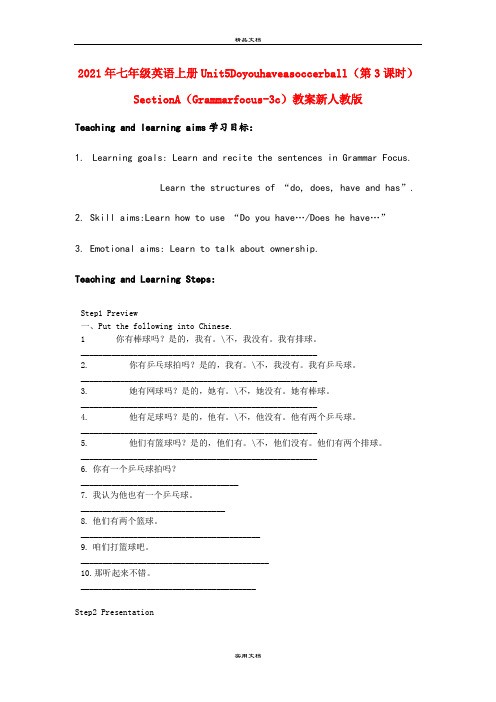
2021年七年级英语上册Unit5Doyouhaveasoccerball(第3课时)SectionA(Grammarfocus-3c)教案新人教版Teaching and learning aims学习目标:1. Learning goals: Learn and recite the sentences in Grammar Focus.Learn the structures of “do, does, have and has”.2. Skill aims:Learn how to use “Do you have…/Does he have…”3. Emotional aims: Learn to talk about ownership.Teaching and Learning Steps:Step1 Preview一、Put the following into Chinese.1 你有棒球吗?是的,我有。
\不,我没有。
我有排球。
______________________________________________________2. 你有乒乓球拍吗?是的,我有。
\不,我没有。
我有乒乓球。
______________________________________________________3. 她有网球吗?是的,她有。
\不,她没有。
她有棒球。
______________________________________________________4. 他有足球吗?是的,他有。
\不,他没有。
他有两个乒乓球。
______________________________________________________5. 他们有篮球吗?是的,他们有。
\不,他们没有。
他们有两个排球。
______________________________________________________6. 你有一个乒乓球拍吗?____________________________________7. 我认为他也有一个乒乓球。
七年级英语上册Unit5 Do you have a soccer ball知识点全面讲解与练习
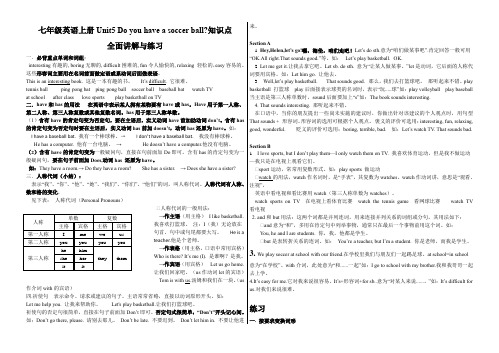
七年级英语上册Unit5 Do you have a soccer ball?知识点全面讲解与练习一.必背重点单词和词组:interesting有趣的, boring无聊的, difficult困难的, fun令人愉快的, relaxing轻松的,easy容易的。
这些形容词主要用在名词前面做定语或系动词后面做表语。
This is an interesting book. 这是一本有趣的书。
It’s difficult. 它很难。
tennis ball ping-pong bat ping-pong ball soccer ball baseball bat watch TVat school after class love sports play basketball on TV二.have和has的用法在英语中表示某人拥有某物要有have或has。
Have用于第一人称、第二人称、第三人称复数或其他复数名词。
has用于第三人称单数。
(1)含有have的肯定句变为否定句,要在主语后,实义动词have前加助动词don’t。
含有has 的肯定句变为否定句时要在主语后,实义动词has前加doesn’t,动词has还原为have。
如:I have a baseball bat. 我有一个棒球棒。
→I don’t have a baseball bat.我没有棒球棒。
He has a computer. 他有一台电脑。
→ He doesn’t have a computer.他没有电脑。
(2)含有have的肯定句变为一般疑问句,直接在句前面加Do即可。
含有has的肯定句变为一般疑问句,要在句子前面加Does,动词has 还原为have。
如:They have a room.→ Do they have a room? She has a sister. → Does she have a sister?三.人称代词(小结):表示“我”、“你”、“他”、“她”、“我们”、“你们”、“他们”的词,叫人称代词。
七年级英语上Unit 5 Do you have a soccer ball
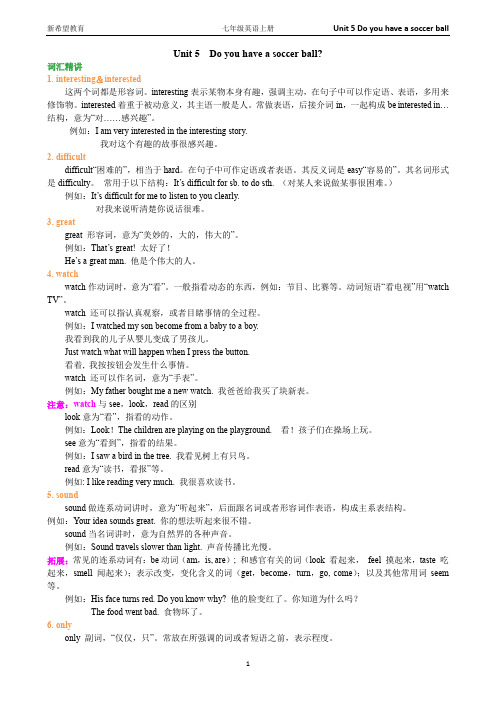
Unit 5 Do you have a soccer ball?词汇精讲1. interesting&interested这两个词都是形容词。
interesting表示某物本身有趣,强调主动,在句子中可以作定语、表语,多用来修饰物。
interested着重于被动意义,其主语一般是人。
常做表语,后接介词in,一起构成be interested in…结构,意为“对……感兴趣”。
例如:I am very interested in the interesting story.我对这个有趣的故事很感兴趣。
2. difficultdifficult“困难的”,相当于hard。
在句子中可作定语或者表语。
其反义词是easy“容易的”。
其名词形式是difficulty。
常用于以下结构:It’s difficult for sb. to do sth. (对某人来说做某事很困难。
)例如:It’s difficult for me to listen to you clearly.对我来说听清楚你说话很难。
3. greatgreat 形容词,意为“美妙的,大的,伟大的”。
例如:That’s great! 太好了!He’s a great man. 他是个伟大的人。
4. watchwatch作动词时,意为“看”。
一般指看动态的东西,例如:节目、比赛等。
动词短语“看电视”用“watch TV”。
watch 还可以指认真观察,或者目睹事情的全过程。
例如:I watched my son become from a baby to a boy.我看到我的儿子从婴儿变成了男孩儿。
Just watch what will happen when I press the button.看着, 我按按钮会发生什么事情。
watch 还可以作名词,意为“手表”。
例如:My father bought me a new watch. 我爸爸给我买了块新表。
七上Unit 5 Do you have a soccer ball语法

实义动词一般现在时结构
1.肯定句: 主语+v+其他 I have a jacket. 主have a book.(对划线部分提问) What do you have?
形容词的用法
• 1. 在名词前做定语 an interesting book.
• 2.在系动词后做表语 He is fine. That sounds good.
Unit 5 Do you have a soccer ball?
Section A
一般现在时
1. Be动词3形态 : am is are 2. 实义动词2形态:动词原形(v)
动词单三(vs)
动词变单三的规则
• 1. +s 例:plays • 2. 以s, x, ch, sh, o结尾的词+es
2.否定句:主语+don’t+v+其他 I don’t like tennis. 主语+doesn’t+v+其他 He doesn’t have a book.
3.疑问句: 一般疑问句:Do/Does+主语+v+其他 Do you like Math? 特殊疑问句:特殊疑问词+ do/does+主语+v+其他
Unit-5---Do-you-have-a-soccer-ball(1)知识点

Unit 5 Do you have a soccer ball ?一、重点单词、词组1、play “玩,耍” ,在句中要灵活翻译。
ping—pong 打乒乓球tennis 打网球soccor 踢英式足球球类名词前面不用play volleyball 打排球冠词the a anbasketball 打篮球sports 参加体育运动2、Let’s = Let us . “让我们” 。
Let’s + V原。
常用来提出一个建议,表示“让我们干……吧” 。
(1)、Let’s play tennis .让我们打网球吧。
(2)、Let’s play computer games . 让我们玩电脑游戏吧。
(3)、Let’s watch TV . 让我们看电视吧。
3、That sounds good . “这个听起来好。
” 该句型常用来肯定对方== interesting 提出的建议。
== fun4、It’s boring / relaxing . 它是无聊的/ 轻松地。
5、sports “ 运动” ,修书名时,它常用复数形式。
sport s club 运动俱乐部sport s collection 运动收藏品本块习题:1、补全对话A:Let’s ______TV . B:That sounds ______ . I don’t like watching TV .A:______ you have a ping—pong hat ? B:Yes , I doA:Let’s______ ping—pong . B:That sounds ______. Let’s go .2、改错(1)、Let’s play the basketball . (2)、Let’s play a volleyball .A B C A B C(3)、Let’s watches TV . (4)、That sound interesting .A B A B(5)、I have a great sport collection . (6)、He has many sports club .A B C A B C二、重点句型:Let's play soccer.That sounds good.Do you have a soccer ball?No, I don't.I have two tennis rackets.let's play tennis.I think he has a ping-pong ball.That sounds interesting.Let's play soccer.I don’t have a soccer ball.We play it at school with our friends.It’s relaxing.I love sports,but I don’t play them,I only watch them on TV.After class, I play ping-pong with my classmate.I don’t have a baseball,but I have a soccer ball.三、一般现在时:(1、现在的状态。
七年级英语上册 Unit 5 Do you have a soccer ball?S

No,s_h__e_d_o__e_s.n’t
6.D__o_e_sMikhe_a_v_e_ a baseball? Yes,_h_e__d_o__e_s.
7.D__o_e_sPeterh_a__v_ea tennis?
_N_o__,he doesn’t.
8. _D_o__ the boys h_a__vea volleyball? _Y__e_s,__t_h_e_ydo.
√
×
Do you have a…. Yes , I do No , I don’t
ping-pong ball
tennis ball
ping-pong bat
soccer ball
baseball / baseball bat
basketball
volleyball
Yes, I do.
Do you have a soccer ball?
Yes, he does. Yes, she does
No ,he doesn’t. No, she doesn’t.
3a Write each word in the correct place in the chart.
I he they you we
do
she it
Eric
does
3b Fill in the blanks with do or does. Then practice the conversation with your partner.
A:
youLeabharlann have a baseball?
B: Yes, I .
A: Great! I have a bat. Let’s play!
七年级英语上册《Unit 5 Do you have a soccer ball》知识点 (新版)人教版

Unit 5 Do you have a soccer ball?1. Do you have......? Yes, I do. No, I don’t..你有……吗?是的,我有。
不,我没有。
Do they have......? Yes, they do. No, they don’t..Does he have......? Yes, he does. No, he doesn’t.Does she have......? Yes, she does. No, she doesn’t.在一般现在时中,句子的谓语动词若是实义动词,常借助助动词do或does来构成否定句或疑问句。
Does用于主语是第三人称单数的句子中,其他情况用do。
2. do/does1)作助动词,帮助构成一般现在时的否定句或疑问句,无意义。
Do you have a soccer ball? 你有足球吗?I don’t know. 我不知道。
Does Jim have a sister? 吉姆有妹妹吗?What does he like? 他喜欢什么?He doesn’t like English. 他不喜欢英语。
2) 作实义动词,“做,干”。
I do my homework every day. 我每天都做家庭作业。
Bob does his homework every day. 鲍勃每天都做家庭作业。
3) 在一般现在时中,do/does 可用来替代上文出现过的动词,以避免重复。
Do you have a soccer ball? 你有足球吗?Yes, I do. 是的,我有。
(do 代have)Does she have an eraser? Yes, she does.I don’t have a soccer ball, but my brother Alan d oes.我没有足球,但我的哥哥艾伦有。
3.Let’s do sth. “(让)我们做某事吧。
七年级上 Unit5 Do you have a soccer ball
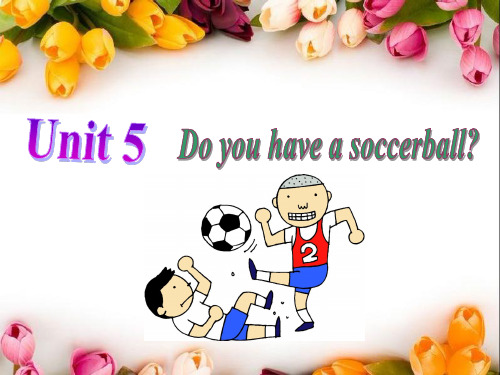
一.用do的适当形式填空。
1. _D_o__e_s_ he watch TV at night?
Yes, he does.
2. _D__o__ you go to school everyday(每天)?
1a Match the words with the pictures.
e
a
d
b
1b Listen and check (√) the description words you
hear in 1a.
√
√
√
1c Listen again. What does Paul say about these
Do you have a soccer ball? 第一课时
Do助动词,第三人称单数形式does。 助动词开头的句子和Be动词开头的句子 一样属于一般疑问句。
I have a soccer ball.
(改为一般疑问句) 分析:原句没有be动词,加一个助动词, 人称要对应。
Do you have a soccer ball ?
Cindy: Helen:
Hey,
OK.
Helen,
l—et—’s
go!
We’r—e —late!
Cindy: —Do—you have the baseball? Helen: Yes, I d—o—. It’s in my bag. Cindy: And where’s our baseball bat?
boring 没趣的;令人厌倦的
七年级英语上册Unit5Doyouhaveasoccerball知识汇总大全(带答案)
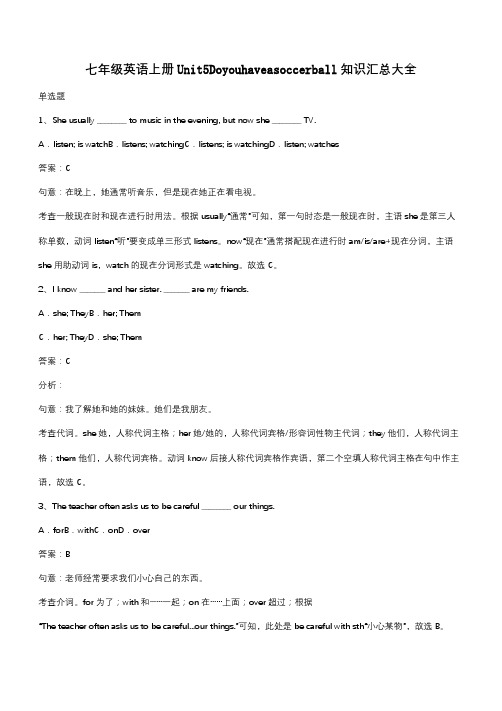
七年级英语上册Unit5Doyouhaveasoccerball知识汇总大全单选题1、She usually ________ to music in the evening, but now she ________ TV.A.listen; is watchB.listens; watchingC.listens; is watchingD.listen; watches答案:C句意:在晚上,她通常听音乐,但是现在她正在看电视。
考查一般现在时和现在进行时用法。
根据usually“通常”可知,第一句时态是一般现在时,主语she是第三人称单数,动词listen“听”要变成单三形式listens。
now“现在”通常搭配现在进行时am/is/are+现在分词,主语she用助动词is,watch的现在分词形式是watching。
故选C。
2、I know _______ and her sister. _______ are my friends.A.she; TheyB.her; ThemC.her; TheyD.she; Them答案:C分析:句意:我了解她和她的妹妹。
她们是我朋友。
考查代词。
she她,人称代词主格;her她/她的,人称代词宾格/形容词性物主代词;they他们,人称代词主格;them他们,人称代词宾格。
动词know后接人称代词宾格作宾语,第二个空填人称代词主格在句中作主语,故选C。
3、The teacher often asks us to be careful ________ our things.A.forB.withC.onD.over答案:B句意:老师经常要求我们小心自己的东西。
考查介词。
for为了;with和……一起;on在……上面;over超过;根据“The teacher often asks us to be careful...our things.”可知,此处是be careful with sth“小心某物”,故选B。
- 1、下载文档前请自行甄别文档内容的完整性,平台不提供额外的编辑、内容补充、找答案等附加服务。
- 2、"仅部分预览"的文档,不可在线预览部分如存在完整性等问题,可反馈申请退款(可完整预览的文档不适用该条件!)。
- 3、如文档侵犯您的权益,请联系客服反馈,我们会尽快为您处理(人工客服工作时间:9:00-18:30)。
七年级英语上册知识点总结:
Unit 5
1.短语归纳:
soccer ball 英式足球 a tennis bat 一个网球拍baseball bat 棒球棒
play basketball 打篮球 play sports 参加体育运动或比赛in my bag 在我的包里
watch TV 看电视 on TV 电视上 be late 迟到
2.一般现在时态中have的用法
have意为“有”,表示所属关系,有人称和数的变化,其主语一般是人,有时也可以是物。
(1)have用于复数名词、第一、二人称单复数或第三人称复数代词作主语的句子中;has为
have的第三人称单数形式,用于不可数名词、可数名词或第三人称单数代词作主语的句
子中。
例:I have a pen. 我有一支钢笔。
(2) have / has的一般疑问句:在句首加助动词do或does,句尾加问号构成。
除第三人称单数
用does外,其余都用do.第三人称前加does后,have / has作谓语时,句中的谓语动词
has要变成have。
例:He has a pen. 他有一个钢笔。
(3) 否定句式:主语+don’t / doesn’t +have…
I don’t have an eraser. 我没有橡皮。
He doesn’t have an eraser. 他没有橡皮。
(4)一般疑问句式:Do/ Does+主语+have…
Does he have a cup? 他有一个茶杯吗?
肯定答语:Yes,主语+do / does.
否定答语:No, 主语+don’t / doesn’t.
(5)当have / has后的名词被some修饰时,在否定句和疑问句中some 要变成any.
I have some good friend.→I don’t have any good friend.
3.Let’s=Let us 让我们……吧。
4.That sounds good.主语+系动词+表语
5.play+the+乐器,play+球类运动名词。
